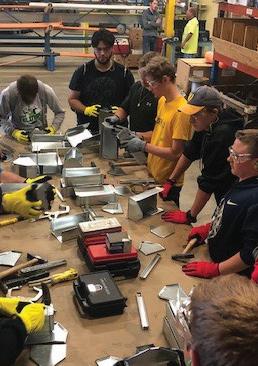
4 minute read
Generation Z Grows Up
GENERATION Z GROWS UP
By Jordan Whitehouse

Youth are targeted as Brand Ambassadors for the sheet metal industry through the My Job is My Gym #mjmg initiative.
Photo courtesy of Lisa Bordeaux.
If she didn’t know it already, Dajen Bohacek knew it by the end of 2017: text message is king for Generation Z.
Earlier that year Bohacek, the associate director of SMACCA Milwaukee, helped set up a youth apprenticeship program, and part of the job was communicating with would-be high school apprentices. She found out quickly that leaving voice messages about jobs or class cancellations wouldn’t be an option. “They often don’t even set up their voicemails, and they look at you like you’re crazy if you ask them to,” she says with a laugh.
It’s a small example, but generational differences like it are beginning to play out across the working world. According to research from Bloomberg, Generation Z, born between 1997 and 2012, will make up 32% of the global population by the end of 2019. That’s more than any other generation, including millennials.
Of course, not every member of Gen Z is of working age yet—the youngest is seven, the oldest is 22—but millions of them are graduating from high school every year and trying to figure out what they want to do with their lives. Voicemail battles aside, one enticing option could be the trades, say a growing number of experts, including sheet metal professionals and those skilled in marketing to youth.
Opportunity knocks
One of those experts is David Stillman, the co-founder of management consulting firm Gen Z Guru. He says the big thing to remember about this generation is that they came of age during the recession. “That means they’re a bit more realistic, a bit more cautious of the traditional path of going to college and going into massive debt,” Stillman says. “We know that 75% of them feel there is still a good way of getting an education other than going to college.”
That doesn’t mean Gen Z isn’t going to college, but this attitude has opened the door for education alternatives that are affordable, short term, and able to generate a good salary right away.
This means they are the perfect fit for apprenticeships in the trades, particularly construction. It’s good news, since the U.S. Bureau of Labor Statistics projects that by 2022 one-third of all new jobs will be in construction, healthcare, and personal care. However, it can’t be recruitment as usual with Generation Z.
Even those individuals who have heard of the sheet metal industry know very little about the variety of career opportunities available within the industry.
“The website for every company and training center should have a big button labeled ‘Careers’ front and center explaining what it is like to work and train in the industry,” Stillman says. “It should go on to clarify that the sheet metal industry encompasses many career paths from testing, adjusting and balancing; detailing and computer-aided design; welding; estimating; supervision; and more.”
Further, while members of Gen Z say they value “mentorship”, they don’t necessarily associate “apprenticeship” with the concept, warns Lisa Bordeaux, a consultant for the SMACNA and SMART Best Practices Market Expansion Task Force who has almost 20 years of experience working with the construction trades.
“This peer group has the perception that apprentices are simply underlings who are treated as grunts on the job. When they learn that apprenticeship involves a mentor-mentee relationship, they are suddenly more interested.”
Milwaukee bucks the trend
SMACCA Milwaukee, Local 601, and several member contractors are trying to get ahead of generational divides through sponsoring a youth apprenticeship program in high schools. Part of Wisconsin’s School to Work initiative, the program allows students to simultaneously earn high school credits while receiving a paycheck for working in the field. Of the 30 students who enrolled in the program during its three years in existence, three-quarters of them subsequently applied to a trade apprenticeship program.
Another initiative started two years ago at the Barack Obama School of Career and Technical Education, when SMACCA Milwaukee and Local 18 discovered a disused HVAC lab in the school’s basement. They helped clean it up and put it back into use. A member from Local 18 is now teaching sheet metal classes there to approximately 10 students each year. Local 18 Business Representative Stu Wilson considers the lab a resource for recruiting new apprentices.
Programs like these are never without hiccups, but the strong partnership between Local 18 and SMACCA Milwaukee has allowed them to flourish.
“Whenever a situation arises, we are able to resolve it quickly with a phone call,” Wilson says.

High school students visit Total Mechanical to work on toolboxes, a hands-on activity that was part of a summer camp for youth.
Photo courtesy of Dajen Bohacek.
The result of Milwaukee’s efforts has not only generated more interest in the industry from Gen Z as a whole, but also specifically from groups not previously well-represented in the profession, including minorities and women. “Attracting the best from the community, regardless of background, race, or gender makes us stronger,” Bohacek says.
Bohacek agrees. “Local 18 has been great in terms of thinking outside the box and trying new ways to solve problems. If a hurdle presents itself, we talk through it, figure out a solution, and move forward.”
“This kind of thinking appeals to members of Gen Z,” Bordeaux says. She believes that going to students and talking to them in a language they understand will open doors to be able to attract the top 20% of them into the industry. “Further, you’ll end up with a very different, very engaged, and very awesome workforce.”
And that’s exactly why Bohacek uses a lot more text messages these days with young apprentices. ▪
Jordan Whitehouse is a freelance business journalist from Vancouver, British Columbia, who writes for magazines, newspapers and online publications throughout Canada and the United States.






